Colonial Jewels in Michoacán
(22nd – 29th, April 2016)
After our visit to Paricutin we no longer had any thoughts about leaving the Cuota in Michoacan and so enjoyed our drive through the hilly landscape towards our next destination, which was no less a pleasant surprise.
Patzcuaro – a Taste of Mexican Liveliness
The town of Patzcuaro is also a “Pueblo Magico”, which in our opinion really deserves the honored title, and to make it all the better there is a nice campground on the outskirts of town but still within walking distance to the town center. A very rare occurrence, which made a visit to a city all that much easier for us. So, the following morning we walked into town to explore, wandering first through the narrow streets and alleys that had a similarity to Etzatlan with lots of little tiendas packed full of everything one could imagine. After a while we reached the center of old town which is quite stunning. White plastered colonial buildings arranged in the classic grid pattern spread amongst many narrow streets with several plazas. The center wasn’t only pretty it was also full of life – with Mexican life to be more specific. People, cars, minibuses and street vendors packed every available space all with an incredible noise level! We simply sat and observed the colorful bedlam for a while before deciding to dive into the deep end.
Patzcuaros’ Mercado Principal
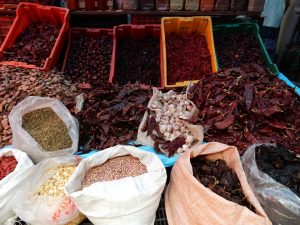 The main market in Patzcuaro was our very first visit to a real Mexican market, something neither of us had experienced before. It took up an entire city block and was absolutely fascinating with stand after stand filled with mountains of all manner of fruits and vegetables. We walked past huge stacks of delicious Mangos, Bananas, Granadillas and all manner of other exotic fruits that set our mouths watering. The plan was to simply take a quick look around but before long we had several bags filled with the yummiest offerings in our hands. On all sides, one could hear the vendors vying for the attention of fickle customers. Often, we were offered tastes of the wares when we tarried a little too long at a particular stand. It is definitely not the ideal place for sufferers of claustrophobia as the market is so full of people one couldn’t help but be jostled and bumped in the narrow paths, or be forced to squeeze through a crowd of people. It also felt as though we were lost in some kind of labyrinth with one path leading to the next and in no time all orientation was gone without a clue as to where we were, or how to leave. No bother though, you can walk through the market for hours simply observing all the different offerings because finding just about everything for sale one could imagine. After the fruit and vegetables, we arrived in the dried section and were greeted by mountains of all manner of dried beans, colorful spices and naturally a variety of chilies you could imagine – after all we were in Mexico. Outside the roof of the stalls were mainly tarpaulin to protect from the sun and rain, but there was also an inside to the market where along with clothing you could find every type of kitchenware imaginable and last but not least a huge meat section, which incidentally we passed through as quickly as possible trying not to breath. Though the smell was quite strong and unappetizing it was nevertheless still interesting to walk through. From half a cow, chickens, pigs’ feet and intestines every part of the animal was for sale either hanging from a hook or lying uncooled in the heat of the afternoon. The smell of decomposing meat was so strong we wondered who in their right mind would buy such meat. Loads of people appeared not to be in their right minds as evident in the long lines of customers waiting to buy meat who apparently didn’t seem to mind the smell at all. For us however, it was all a bit too suspect and decided to continue with our vegetarian dishes until we could find meat that was properly cooled, hygienically stored and neutral smelling. In another section of the market were the cooked food stands are, one could buy a very reasonably priced if not cheap lunch, though after passing through the meat section you would have to have no fear of food poisoning or be a local to eat there. In huge pans (think massive woks) all manner of dishes were being prepared mostly consisting of a mixture of meat, potatoes and vegetables and offered with stacks of the ever present corn tortillas. It looked and smelled very appetizing but we simply didn’t trust the meat and decided instead to limit ourselves to observing and taking photos.
The main market in Patzcuaro was our very first visit to a real Mexican market, something neither of us had experienced before. It took up an entire city block and was absolutely fascinating with stand after stand filled with mountains of all manner of fruits and vegetables. We walked past huge stacks of delicious Mangos, Bananas, Granadillas and all manner of other exotic fruits that set our mouths watering. The plan was to simply take a quick look around but before long we had several bags filled with the yummiest offerings in our hands. On all sides, one could hear the vendors vying for the attention of fickle customers. Often, we were offered tastes of the wares when we tarried a little too long at a particular stand. It is definitely not the ideal place for sufferers of claustrophobia as the market is so full of people one couldn’t help but be jostled and bumped in the narrow paths, or be forced to squeeze through a crowd of people. It also felt as though we were lost in some kind of labyrinth with one path leading to the next and in no time all orientation was gone without a clue as to where we were, or how to leave. No bother though, you can walk through the market for hours simply observing all the different offerings because finding just about everything for sale one could imagine. After the fruit and vegetables, we arrived in the dried section and were greeted by mountains of all manner of dried beans, colorful spices and naturally a variety of chilies you could imagine – after all we were in Mexico. Outside the roof of the stalls were mainly tarpaulin to protect from the sun and rain, but there was also an inside to the market where along with clothing you could find every type of kitchenware imaginable and last but not least a huge meat section, which incidentally we passed through as quickly as possible trying not to breath. Though the smell was quite strong and unappetizing it was nevertheless still interesting to walk through. From half a cow, chickens, pigs’ feet and intestines every part of the animal was for sale either hanging from a hook or lying uncooled in the heat of the afternoon. The smell of decomposing meat was so strong we wondered who in their right mind would buy such meat. Loads of people appeared not to be in their right minds as evident in the long lines of customers waiting to buy meat who apparently didn’t seem to mind the smell at all. For us however, it was all a bit too suspect and decided to continue with our vegetarian dishes until we could find meat that was properly cooled, hygienically stored and neutral smelling. In another section of the market were the cooked food stands are, one could buy a very reasonably priced if not cheap lunch, though after passing through the meat section you would have to have no fear of food poisoning or be a local to eat there. In huge pans (think massive woks) all manner of dishes were being prepared mostly consisting of a mixture of meat, potatoes and vegetables and offered with stacks of the ever present corn tortillas. It looked and smelled very appetizing but we simply didn’t trust the meat and decided instead to limit ourselves to observing and taking photos.
Patzcuaro is quite diverse in that besides the pure Mexican chaos one can enjoy the experience of the colonial flare it offers. The various plazas are surrounded by quaint hotels and restaurants with wonderful terraces and shaded courtyards where you can escape the afternoon heat. It was a real treat to simply go from one building to the next and enjoy the spectacular architecture. A highlight of the city is the library which we also decided to visit. The inner face of the entire rear wall is taken up by a huge impressive painting depicting the sad and tortured story of the conquering of the Purépecha people by the conquistadors. After meeting many members of the remaining Purepecha the cruelty depicted in the painting affected us quite deeply.
Possibly The Worlds Ugliest Statue
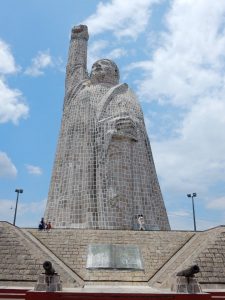 A visit to Patzcuaro is not complete without a visit to the island of Janitzio, which lies, along with a few other islands, in the nearby lake Patzcuaro. The island is on almost every postcard and of course looks quite interesting. So, naturally we had to go even though we knew it was probably nothing more than a tourist trap. Nevertheless, we boarded one of the shallow hulled water taxis the next day which also quickly filled with Mexican tourists (foreign tourists were for the most part still a rarity) and a few indigenous overloaded with goods from the market. Before the boat left however, we were visited by the obligatory ice-cream, candy and snack vendors and a few minutes later a Mexican band boarded and played the entire trip to the island. There was definitely a party mood on board and a few folks had drinks in hand and somewhat glassy eyes by the time we arrived at the island. To Mexican rhythms we slowly approached near enough to the island to get our first glimpses and from a distance it still looked relatively idyllic. The lake reminded one more of dirty soup than of water and the closer we got to the island the less attractive it was. The island is cluttered by mostly poor huts arranged in circles climbing the island to the very top, which is overlooked by a huge incredibly ugly statue of José María Morelos – a great hero of Mexican independence. The ugliness of the status is even mentioned in guide books and has managed to gain an almost cult status because of its sheer dreadfulness. Long ago the island inhabitants made their living from farming or fishing (using a very unique butterfly net), but today that is all but impossible. They now earn most, if not all, of their income from tourism. One is forced to snake ones’ way up to the top running a gauntlet of innumerable kitschy souvenir shops, restaurants and other vendors all the while being harried from all sides to buy something before reaching the top of the island. Once there you have to pay an entrance fee and walk through an array of more vendors, food stalls and souvenir sellers before getting to take a photo of the appalling statue. The only thing that is really interesting on the island is the “Jarra Loca” (crazy glass) – a mixture of beer, rum, orange juice, grenadine, chili and salt – something you just have to try if you are there, though in our opinion the island is not necessarily worth the visit, but the Mexicans seemed to be enjoying themselves tremendously; snapping photos and everyone seemed to have at least one Jarra Loca in their hand or a beer or both. Needless to say, the return trip was very boisterous.
A visit to Patzcuaro is not complete without a visit to the island of Janitzio, which lies, along with a few other islands, in the nearby lake Patzcuaro. The island is on almost every postcard and of course looks quite interesting. So, naturally we had to go even though we knew it was probably nothing more than a tourist trap. Nevertheless, we boarded one of the shallow hulled water taxis the next day which also quickly filled with Mexican tourists (foreign tourists were for the most part still a rarity) and a few indigenous overloaded with goods from the market. Before the boat left however, we were visited by the obligatory ice-cream, candy and snack vendors and a few minutes later a Mexican band boarded and played the entire trip to the island. There was definitely a party mood on board and a few folks had drinks in hand and somewhat glassy eyes by the time we arrived at the island. To Mexican rhythms we slowly approached near enough to the island to get our first glimpses and from a distance it still looked relatively idyllic. The lake reminded one more of dirty soup than of water and the closer we got to the island the less attractive it was. The island is cluttered by mostly poor huts arranged in circles climbing the island to the very top, which is overlooked by a huge incredibly ugly statue of José María Morelos – a great hero of Mexican independence. The ugliness of the status is even mentioned in guide books and has managed to gain an almost cult status because of its sheer dreadfulness. Long ago the island inhabitants made their living from farming or fishing (using a very unique butterfly net), but today that is all but impossible. They now earn most, if not all, of their income from tourism. One is forced to snake ones’ way up to the top running a gauntlet of innumerable kitschy souvenir shops, restaurants and other vendors all the while being harried from all sides to buy something before reaching the top of the island. Once there you have to pay an entrance fee and walk through an array of more vendors, food stalls and souvenir sellers before getting to take a photo of the appalling statue. The only thing that is really interesting on the island is the “Jarra Loca” (crazy glass) – a mixture of beer, rum, orange juice, grenadine, chili and salt – something you just have to try if you are there, though in our opinion the island is not necessarily worth the visit, but the Mexicans seemed to be enjoying themselves tremendously; snapping photos and everyone seemed to have at least one Jarra Loca in their hand or a beer or both. Needless to say, the return trip was very boisterous.
Back in Patzcuaro we were too tired after our busy day to think about cooking and decided to try one of the local specialties: fire roasted chicken marinated in chili sauce. It tasted amazing, however, we arrived at a very strange conclusion: Most probably the chicken was bought from the same market we visited earlier, even more probably from the huge stack of raw chickens we saw laying stewing in the afternoon sun, but, and here’s the kicker, we weren’t sure and besides it smelled and tasted wonderful and we didn’t have to buy or cook it ourselves. We decided not to think anything more about where the chicken may have come from and simply hope that everything was ok…
Awesome Hospitality in Morelia
As previously mentioned visiting big cities is a rarity for us since they require a lot of planning to work with our vehicle. It wasn’t actually our intention to visit the capitol city of Michoacán at all, though we quite accidently met Armando and several of his friends in Angahaun who also did a tour of the volcano. After a long chat with him he spontaneously invited us to his parents’ house in Morelia. He informed us that he may not be there personally but assured us that his parents love receiving visitors. At first, we were a little puzzled with the unusual offer but curiosity got the better of us and so we made our way to Morelia. The route led us through a few poorer neighborhoods before climbing steeply up a huge hill overlooking the city to the front gate of the Manzano family where we looked about us with a large dose of uncertainly. The area didn’t look exactly welcoming, all the surrounding houses had huge walls topped with either barbed, electrically charged wire or glass shards and massive iron gates that abutted the road. It looked a bit foreboding. Oh well, we could at least stop in and say hello so without further ado we rang the doorbell. As the gate finally opened we entered into another world: Suddenly we found ourselves in a magic garden filled with trees, flowers, a well-tended courtyard and a housekeeper that lead us up to the house. The family was still out, but she knew we were coming and was supposed to show us to our room. She led us to an outbuilding and into an apartment with its’ own full kitchen and bathroom! It looked more like a nicely appointed suite than a guest room and so we asked ourselves if just maybe we misunderstood Armando and he actually meant that his parents rent rooms out and if we wanted to, we could rent one if we decided to visit Morelia. A room of that quality was definitely out of our budget so we decided to be prudent and not move any of our stuff into the room but instead wait for the family to arrive and clear up the obvious misunderstanding. A good half an hour later they arrived: Señor Manzano, who introduced himself as Armando senior and his wife Sandra were followed a few minutes later by Armando junior and his girlfriend. So, we hesitantly asked him what he actually meant by the invite, naturally the entire family had a good laugh at the question and eased our misgivings: Yes, we were really invited and yes that was our apartment for as long as we wanted to stay without any thoughts of compensation. Almost speechless we moved a few things in, still not quite believing our luck! If that wasn’t enough we were also invited for lunch, which the housekeeper had already prepared with us in mind. We learned that Armando Senior is a university professor and that the apartments are also rented out to students, though the family does actually enjoy visits from all over the world. Sandra is a multi-lingual translator, needless to say they all speak perfect English which made communicating very easy for us. We were touched with all the generosity and felt very welcomed and comfortable with the family. For desert, we were introduced to the local specialty: Dulces, a type of hard jelly made from several types of fruit that come in a variety of shapes and taste combinations. Morelia is quite famous for its Dulces and there is even a separate market and museum dedicated to the tantalizing treats. They had an entire platter full to try – and with a little encouragement from the Manzanos we did manage to try them all – some were even tastier combined with cheese. With all the sampling, we were so stuffed that we certainly wouldn’t need any supper, which interestingly enough is generally quite small in this part of Mexico anyway, as we found out. People in Morelia generally eat a large lunch rather late (between 2 and 3pm) and then only eat something small for supper like fruit, pastries or a few Tortillas. The meal times and customs fluctuate to the extreme depending on which region of Mexico one is visiting. In some areas restaurants are getting ready to close at 18:00 and in others, one is still too early at 20:00…
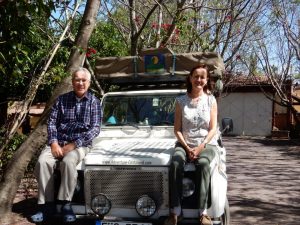 Since it was so pleasant, and we felt so welcomed by the family, we decided to spend a few days in Morelia. The old town is one of the Colonial Jewels of Mexico with noble buildings and roads – very beautiful, but when one comes from Europe and such historical buildings are an everyday occurrence it’s nothing out of the ordinary. For us the highlight of our visit was definitely our stay with the Manzano family. We went shopping with Sandra and she showed us quaint little tiendas in their neighborhood, where to get the best fresh fruit and veggies and where we could find the tastiest pastries. From her we also learned how to eat salad in Mexico. Before then we followed the strict advice of the travel doctors to either “cook it, peel it or leave it!” Which is still good advice for people going to Mexico on vacation for the normal 2-3 weeks, but what about for months? We had begun to ask ourselves if those who offered such advice were ever abroad for longer than the standard vacation times because with that advice the meal plan is drastically reduced. Add to that an already limited regional variety and it is even more restrictive which after only a couple weeks starts to play havoc with the digestion. So, we were very thankful for the tips and advice that we received from Sandra, which broadened our menu dramatically: Either find a big supermarket which has packaged salad that is “Listo para comer” (ready to eat or pre-washed) – which you can eat without worry, or there is “Microdyn” (Silver oxide drops), which you can buy just about everywhere and can be used to disinfect salad or veggies and even purify water. Lastly, for everything that can be washed (hard peels etc.) she suggested that we simply wash everything with dish soap and drinking water. Those are some really useful tips! Unfortunately, you won’t hear them from a travel doctor. We were nevertheless very happy to have the option to eat salad and other fresh raw foods once again!
Since it was so pleasant, and we felt so welcomed by the family, we decided to spend a few days in Morelia. The old town is one of the Colonial Jewels of Mexico with noble buildings and roads – very beautiful, but when one comes from Europe and such historical buildings are an everyday occurrence it’s nothing out of the ordinary. For us the highlight of our visit was definitely our stay with the Manzano family. We went shopping with Sandra and she showed us quaint little tiendas in their neighborhood, where to get the best fresh fruit and veggies and where we could find the tastiest pastries. From her we also learned how to eat salad in Mexico. Before then we followed the strict advice of the travel doctors to either “cook it, peel it or leave it!” Which is still good advice for people going to Mexico on vacation for the normal 2-3 weeks, but what about for months? We had begun to ask ourselves if those who offered such advice were ever abroad for longer than the standard vacation times because with that advice the meal plan is drastically reduced. Add to that an already limited regional variety and it is even more restrictive which after only a couple weeks starts to play havoc with the digestion. So, we were very thankful for the tips and advice that we received from Sandra, which broadened our menu dramatically: Either find a big supermarket which has packaged salad that is “Listo para comer” (ready to eat or pre-washed) – which you can eat without worry, or there is “Microdyn” (Silver oxide drops), which you can buy just about everywhere and can be used to disinfect salad or veggies and even purify water. Lastly, for everything that can be washed (hard peels etc.) she suggested that we simply wash everything with dish soap and drinking water. Those are some really useful tips! Unfortunately, you won’t hear them from a travel doctor. We were nevertheless very happy to have the option to eat salad and other fresh raw foods once again!
When Armando came home in the evenings we were treated to various family stories and more than once we were left in stiches laughing at their antics. Our time with the family flew by and all too soon it was time to move on. As a small token of our appreciation for the unbelievable hospitality they showed us we offered to cook a meal for the family. Classic “Flammkuchen” (German pizza) was probably something that they had never heard of. Thanks in part to being in a big city we were also able to find all the ingredients that we needed. Everyone was thrilled with supper and desert “Heiße Liebe” (“Hot love” – vanilla ice cream with a hot raspberry compote) provided its own amusement when translated. They asked us for the recipes for everything and Flammkuchen was such a hit it was destined for the family recipe book. With a heavy heart, we said our goodbyes to Armando and Sandra the next day to continue our journey.
Muchas Gracias…
…for the unforgettable and incredible hospitality! Our visit with you was very special for us and will forever be a fond memory!
More Photos on Flickr: Colonial Jewels in Michoacan

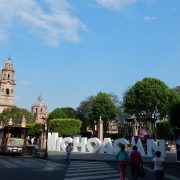
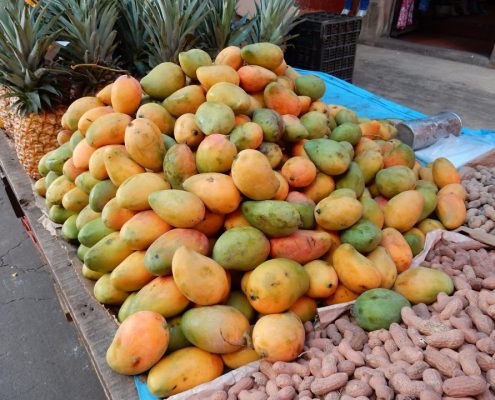
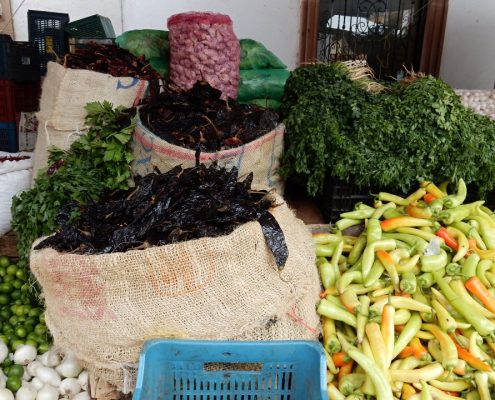
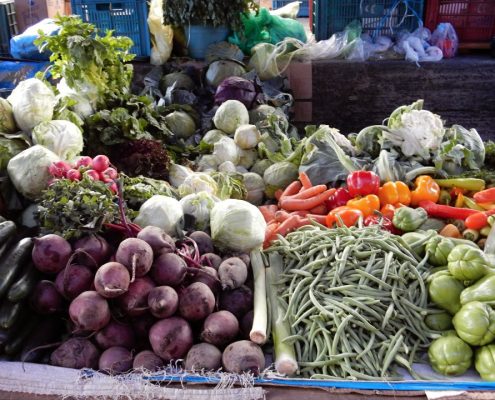
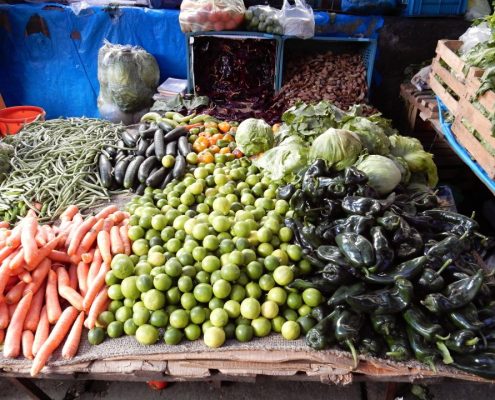
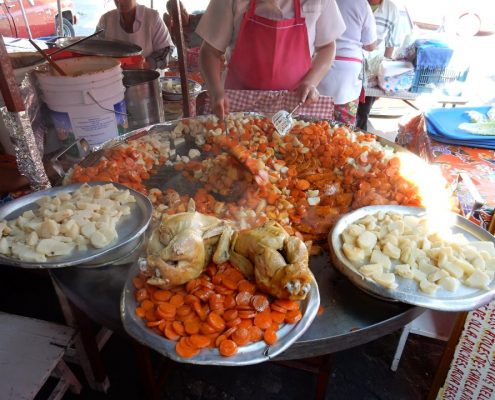
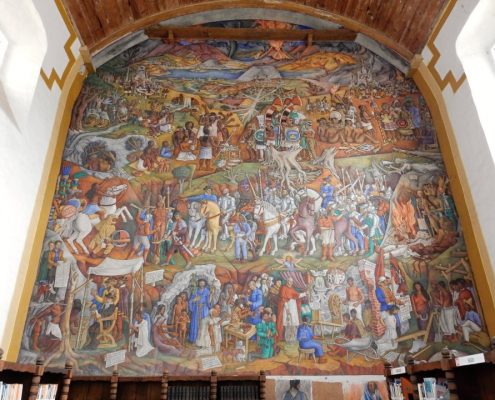
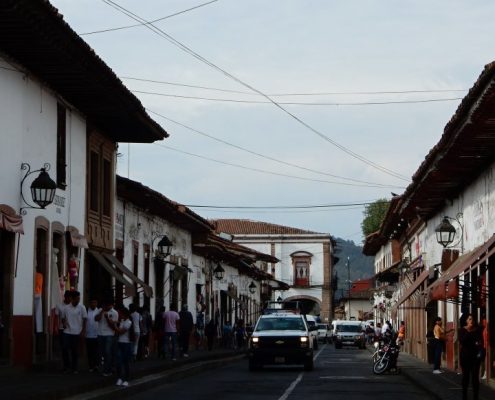
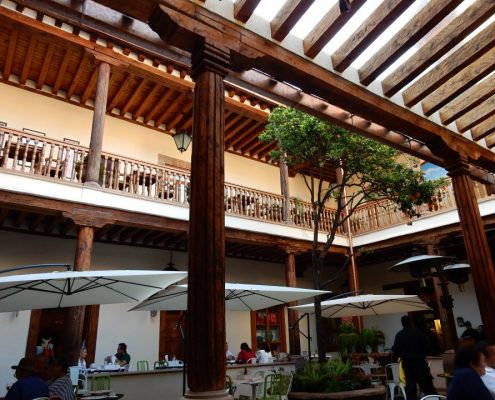
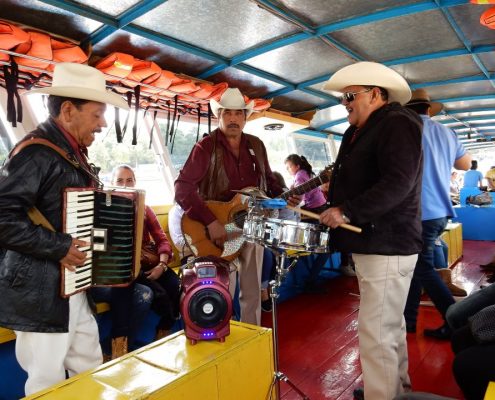
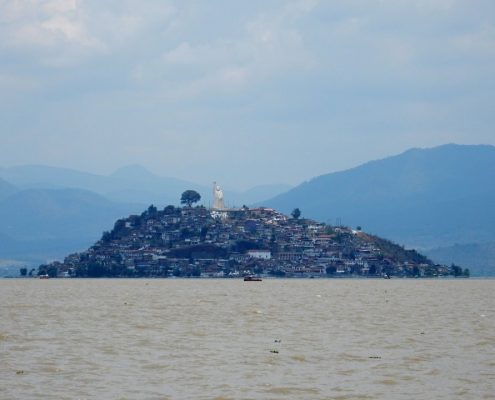
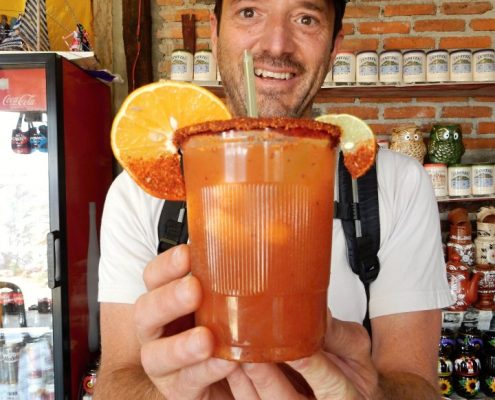
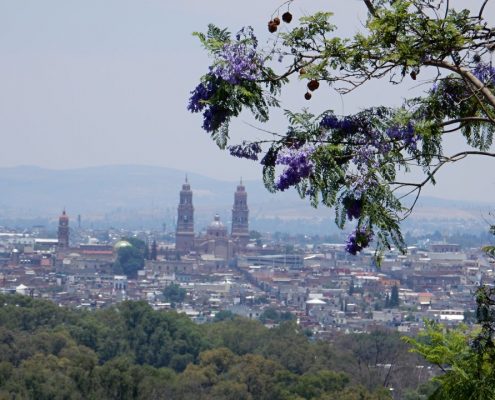
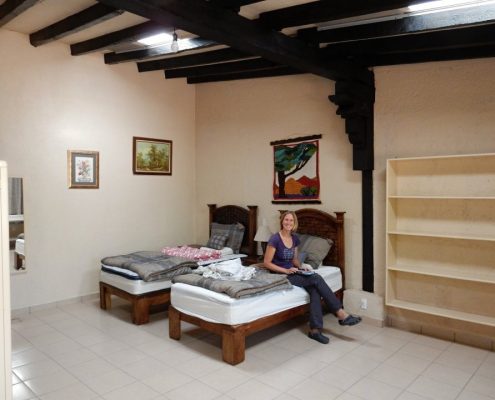
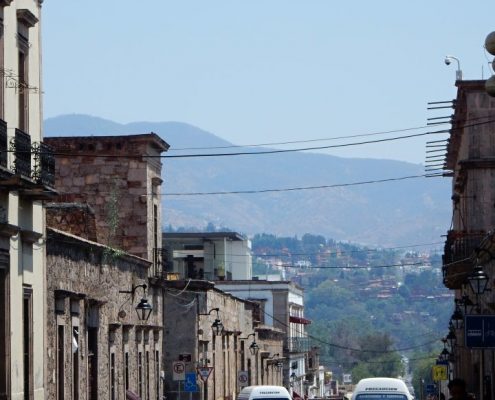
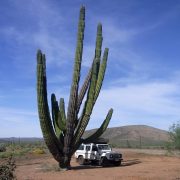
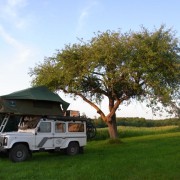
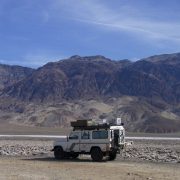
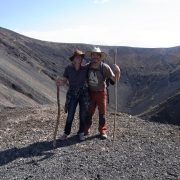
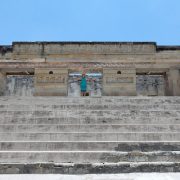
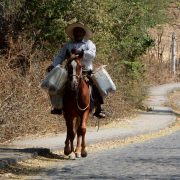
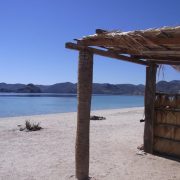
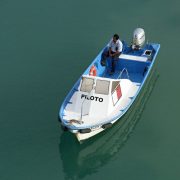


I concur with Priscilla you really need to put this wonderful blog into a book I’d also brag
I really enjoy reading your blogs. You both should think about writing a book maybe in my life time so I can brag